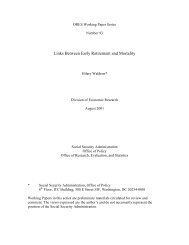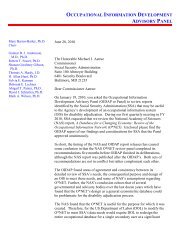Table 4.The evolution of the ARF and the DRC of retirement benefits, by age, 1994–2006Age 1994 1995 1996 1997 1998 1999 2000 2001 2002 2003 2004 2005 200662 0.800 0.800 0.800 0.800 0.800 0.800 0.792 0.783 0.775 0.767 0.758 0.750 0.75063 0.867 0.867 0.867 0.867 0.867 0.867 0.867 0.856 0.844 0.833 0.822 0.811 0.80064 0.933 0.933 0.933 0.933 0.933 0.933 0.933 0.933 0.922 0.911 0.900 0.889 0.87765 1.000 1.000 1.000 1.000 1.000 1.000 1.000 1.000 1.000 0.989 0.978 0.967 0.95566 1.040 1.045 1.045 1.050 1.050 1.055 1.055 1.060 1.060 1.065 1.054 1.047 1.03567 1.080 1.080 1.090 1.090 1.100 1.100 1.110 1.110 1.120 1.120 1.130 1.119 1.11668 1.105 1.120 1.120 1.135 1.135 1.150 1.150 1.165 1.165 1.180 1.180 1.195 1.18469 1.140 1.140 1.160 1.160 1.180 1.180 1.200 1.200 1.220 1.220 1.240 1.240 1.260SOURCE: Authors' compilation of information from the <strong>Social</strong> <strong>Security</strong> Administration.From Table 3 it should be clear that accounting forthe actuarially fair nature of the ARF and the DRC isimportant, and we see that although the numbers inthe table are hardly the same by age or year, they aremostly of the same order of magnitude, suggesting theconsiderable explanatory power of self-selection; thismost likely puts to rest any notion that early retireesare comparatively (and on average) much worse offthan those claiming retirement benefits at later agesfrom SSA. Notice, however, that there is obviously adistribution of monthly benefits underlying these numbers,which might still have a significant proportion ofindividuals with very low level of benefits. Also notethat the standard deviations (not shown in the tables)for those claiming benefits early are actually smallerthan the standard deviations of those claiming at laterages, suggesting that the dispersion is not particularlydifferent for early claimers. An additional explorationof the data shows that the 25 percent percentile of themonthly benefit level is around $612 for those claimingbefore age 65 and $782 for those claiming at age 65or older.A number of researchers have described earlyretirees as comparatively similar to those who claimretirement benefits later (Burkhauser, Couch, and Phillips1996; Smith 1999; Leonesio, Vaughan, and Wixon2000; Mitchell and Phillips 2000), but not in terms ofthe level of benefits they receive. 24 A possible explanationbehind the notion (described as conventional wisdomby Burkhauser, Couch, and Phillips (1996)) thatearly retirees where disproportionally at risk is that itwas developed in a period of time in which claimingearly was relatively less common. With 73.2 percentof Americans currently claiming benefits before theFRA (SSA 2007), it is hardly surprising that the rangeof characteristics of these retirees covers the spectrumof the population. In summary, although we still haveto “beware of the mean” as stated by Quinn (1987) inhis analysis of the economic status of the elderly, thissummary statistic might now be less problematic thanit was a couple of decades ago. 25The most relevant result shown in Table 3, whichbecomes even clearer in Chart 2, is also the mainresult and contribution of this article, which is that thelevel of benefits received by those claiming them afterage 65 (shaded cells) decreased sharply after 2000,and during the following years it becomes increasinglydifferent from the level of benefits received by thoseaged 62–65. The difference from the pre-2000 period,when benefit levels at all ages tend to be within $100of one another, is striking.Those persons aged 62–65 have seen an upwardtrend in their benefit levels possibly resulting from theincrease in the FRA. We can theorize that the increasein the penalty for claiming early can have two relatedeffects. On one hand, one effect (which we could calla scale or wealth effect) should make everyone potentiallyinterested in claiming later because of the factthat in order to reach the previous level of benefits,the claiming needs to be delayed. On the other hand,it is possible that the change in the FRA could affectlower-income career earners more, for whom the newadjusted benefits would fall short of what they consideradequate to make ends meet. The latter wouldsuggest that some of those individuals would chooseto delay benefit claiming slightly, leaving a higherproportion of higher-income earners among thoseclaiming earlier. As we will see later, this interestingresult is mainly driven by male workers.84 <strong>Social</strong> <strong>Security</strong> Bulletin • Vol. 69 • No. 3 • 2009
Chart 2.Average monthly <strong>Social</strong> <strong>Security</strong> retirement benefits, by age, 1994–20042005 ($)1,3501,2501,1501,050950Age62636465666768698507506501994 1995 1996 1997 1998 1999 2000 2001 2002 2003 2004YearSOURCE: OASDI public-use microdata file, 2004.With the elimination of the earnings test, it seemsthat the composition in terms of earnings historiesof those claiming benefits after age 65 has changedconsiderably and now is composed of a higher proportionof individuals trying to catch up after having hadsketchy careers or relatively low earnings histories,although before 2000 there were more high earnersperhaps more focused on the short-term consequencesof the earnings test provisions. 26 Using data on total<strong>Social</strong> <strong>Security</strong> credits, we can analyze whetherreaching fully insured status could be playing animportant role among late claimers. We observe thatthere is a higher percentage of individuals near the40 total credits (quarters of coverage) necessary to beinsured among those claiming after age 65 (otherwisethe distributions are quite similar), but because of thenature of the data we cannot observe the dynamics ofhow these credits were acquired, therefore we cannotpresent definitive evidence of individuals workinglonger after age 65 in order to achieve insured status.However, there is evidence that those claiming benefitslater have comparatively lower total credits, with the10 th percentile at 43 credits for those claiming afterage 65, and at 61 credits for those claiming at age 65.Therefore, it is plausible to believe that many of thoseclaiming later could benefit from the extra years ofwork because they have a bit shorter employmenthistories. 27It would be ideal to additionally explore theseconjectures regarding the composition of claimersusing wage histories, however, this information is notavailable in the public-use microdata. We hope that infuture releases of this data some additional variablesare available, and some of these issues can be studiedin more detail.The sharp upward trend of the benefits received bythose age 65 and those older than age 65 in the lastcouple of years, especially for men, provides someevidence of convergence toward the pre-2000 benefitlevels. This could suggest the possibility that theincreases in the DRC are finally playing a role amongsome workers with higher earnings histories and aremore likely correlated to longer life expectancies ofthose who can gain the most from the permanentincreases in their benefits if they claim later.A clear advantage of using microdata is that wecan now compute test statistics for the statisticalsignificance of these average benefits with respect tothe level of those that claimed, for example, at age 65back in 1994, who at that time received 100 percentof their PIA at this age. Table 5 reports the t-statistics<strong>Social</strong> <strong>Security</strong> Bulletin • Vol. 69 • No. 3 • 2009 85
- Page 1 and 2:
Social SecuritySocial SecurityBulle
- Page 3:
Social SecurityBulletin Vol. 69, No
- Page 6 and 7:
Perspectives77 An Empirical Study o
- Page 8 and 9:
Selected Abbreviations—continuedM
- Page 10:
within the next few years (Aglira 2
- Page 14 and 15:
coverage varies significantly by ra
- Page 16 and 17:
non-Hispanic white, and college edu
- Page 18 and 19:
same groups (Table 6). For the last
- Page 20 and 21:
from DB to DC pensions is accelerat
- Page 22 and 23:
Table 8.Percent of individuals who
- Page 24 and 25:
not necessarily the largest gains a
- Page 26 and 27:
shoring-up DB plans before those pl
- Page 28 and 29:
Table B-1.Percent change in mean pe
- Page 30 and 31:
Table B-3.Percent of individuals wh
- Page 32 and 33:
ReferencesAaronson, Stephanie, and
- Page 35 and 36:
Social Security Administration’s
- Page 37:
Chart 1.Historical expansion of Soc
- Page 40 and 41: self-employment information for the
- Page 42 and 43: (Cronin 1985). The final earnings r
- Page 44 and 45: prior to 1950, first year of earnin
- Page 46 and 47: average indexed monthly earnings (A
- Page 48 and 49: 13For an explanation of how the sel
- Page 50 and 51: Kopczuk, Emmanuel Saez, and Jae Son
- Page 53 and 54: Occupations of SSI Recipients Who W
- Page 55 and 56: on the differences between the occu
- Page 57 and 58: prediction models. Table A-1 lists
- Page 59 and 60: Occupational Distributions of theEm
- Page 61 and 62: similar, only 4 percent of the popu
- Page 63 and 64: Table 5.Estimated occupational dist
- Page 65 and 66: Table 7.Predicted Herfindahl-Hirsch
- Page 67 and 68: Table 9.Estimated occupational dist
- Page 69 and 70: Table 11.Average annual wages of wo
- Page 71 and 72: Table A-2.Means and standard errors
- Page 73 and 74: Table A-3.Coefficients and standard
- Page 75 and 76: Table A-3.Coefficients and standard
- Page 77 and 78: Table A-3.Coefficients and standard
- Page 79 and 80: management, professional, and relat
- Page 81: Stapleton, David C., Nanette Goodma
- Page 84 and 85: Selected Abbreviations—continuedO
- Page 86 and 87: The 1983 Amendments to the Social S
- Page 88 and 89: Chart 1.Proportion of new claimants
- Page 92 and 93: for the test of equality of means b
- Page 94 and 95: Table 8.Average monthly Social Secu
- Page 96 and 97: in the chart, especially for men, t
- Page 98 and 99: 6This is a very important character
- Page 100 and 101: Benítez-Silva, Hugo, Berna Demiral
- Page 103 and 104: OASDI and SSI Snapshot andSSI Month
- Page 105 and 106: Monthly Statistical Snapshot, Augus
- Page 107 and 108: Table 2.Recipients, by eligibility
- Page 109 and 110: SSI Federally Administered Payments
- Page 111 and 112: Table 7.Average monthly payment, by
- Page 113: Awards of SSI Federally Administere
- Page 116 and 117: Copyright—Authors are responsible
- Page 119 and 120: Program Highlights, 2009Old-Age, Su








